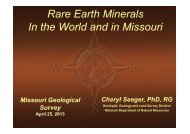You also want an ePaper? Increase the reach of your titles
YUMPU automatically turns print PDFs into web optimized ePapers that Google loves.
Mud creek, nW¼nE¼ sec. 19, t. 44 n., r.<br />
91 W., Washakie county<br />
The black sands <strong>in</strong> the Mesaverde Formation just<br />
north of Mud Creek were described by Houston<br />
and Murphy (1962), with some details added by<br />
K<strong>in</strong>g and Harris (2002). The titaniferous black<br />
sandstone occurs <strong>in</strong> the uppermost part of the<br />
basal sandstone of the Mesaverde and has a maximum<br />
thickness of 2.3 m (7.5 ft) and an exposure<br />
width of about 460 m (1,500 ft). Houston and<br />
Murphy (1962) reported that the heavy m<strong>in</strong>eral<br />
suite conta<strong>in</strong>s 5 percent zircon. Another sample,<br />
collected by Madsen (1978), conta<strong>in</strong>ed 500 ppm<br />
lanthanum.<br />
Recent samples collected from the upper part of<br />
the Mesaverde outcrop, about 0.5 km (0.3 mi)<br />
northeast of the 1962 and 1978 samples, showed<br />
no REE enrichment. These apparently were<br />
stratigraphically higher <strong>in</strong> the formation than the<br />
titaniferous black sandstone described by Houston<br />
and Murphy (1962). Sample 20120731WS-G is<br />
a dark brown, f<strong>in</strong>e- to medium-gra<strong>in</strong>ed, iron-rich,<br />
discont<strong>in</strong>uous sandstone about 0.9 m (3 ft) thick.<br />
Its dark color is mostly due to surface coat<strong>in</strong>gs.<br />
This iron-rich sandstone is overla<strong>in</strong> by a thick,<br />
white, cross-bedded sandstone near the top of the<br />
Mesaverde Formation (Sample 20120731WS-F)<br />
that also showed no REE enrichment.<br />
dugout creek, nE¼sW¼ sec. 11, t. 44 n.,<br />
r. 89 W., Eastern Washakie county<br />
The titaniferous black sandstone <strong>in</strong> the Dugout<br />
Creek deposit is <strong>in</strong> the upper part of the basal<br />
Mesaverde Formation and is radioactive <strong>in</strong> some<br />
outcrops. The black sandstone crops out across<br />
several sections and its thickness varies from about<br />
0.9 to 7.6 m (3 to 25 ft), but averages 3.0 to 4.6 m<br />
(10 to 15 ft) (Houston and Murphy, 1962). This<br />
is the most extensive exposure of Mesaverde black<br />
sandstone <strong>in</strong> Wyom<strong>in</strong>g.<br />
Zircon makes up 5 percent of the total heavy<br />
m<strong>in</strong>eral content of the black sandstone here and<br />
monazite accounts for 1 percent. Uranium content<br />
reportedly varies from 0.001 to 0.021 percent eU,<br />
depend<strong>in</strong>g on which earlier <strong>in</strong>vestigation is cited<br />
(K<strong>in</strong>g and Harris, 2002). Madsen (1978) reported<br />
one sample that conta<strong>in</strong>ed 312 ppm lanthanum.<br />
51<br />
A recent WSGS sample from this location (Sample<br />
20120731WS-H) consists of f<strong>in</strong>e- to mediumgra<strong>in</strong>ed,<br />
dark-brown to purple and orange, crossbedded<br />
sandstone about 0.9 m (3 ft) thick that<br />
overlies a yellowish brown sandstone. The darkbrown<br />
sandstone outcrop is about 0.40 km (0.25<br />
mi) <strong>in</strong> length at this locality. A similar layer is<br />
noted about 1.6 km (1 mi) to the north and appears<br />
to be cont<strong>in</strong>uous for 0.4 to 0.8 km (0.25 to<br />
0.5 mi). Several prospect pits are found near the<br />
sample site. Sample 20120731WS-H is 12 percent<br />
TiO 2 and slightly enriched <strong>in</strong> scandium, yttrium,<br />
niobium, and all of the REE except dysprosium<br />
and holmium. The LREE, ytterbium, and niobium<br />
are enriched to greater than five times crustal<br />
abundances.<br />
Lovell, secs. 7 and 12, t. 55 n., r. 95 W.,<br />
northwestern big Horn county<br />
This slightly radioactive, titaniferous, black sandstone<br />
deposit averages 0.9 m (3 ft) thick, with a<br />
maximum thickness of 1.2 m (4 ft). The outcrop<br />
extends along an 11˚ SW dipp<strong>in</strong>g hogback for 914<br />
to 1,524 m (3,000 to 5,000 ft) (K<strong>in</strong>g and Harris,<br />
2002). Houston and Murphy (1962) reported zircon<br />
<strong>in</strong> the heavy m<strong>in</strong>eral fraction, but no monazite.<br />
A sample from this deposit by Garrand and others<br />
(1982) showed 50 ppm lanthanum, greater than 20<br />
ppm niobium, 40 ppm yttrium, 200 ppm zircon,<br />
and 8 ppm cU 3 O 8 (20 ppm eU 3 O 8 ). Madsen<br />
(1978) reported 316 ppm lanthanum <strong>in</strong> a sample<br />
from this deposit.<br />
A recent WSGS sample (20120801WS-A) from<br />
the Lovell deposit represents a dark brown to<br />
purple, th<strong>in</strong>-bedded, f<strong>in</strong>e-gra<strong>in</strong>ed sandstone up to<br />
1.2 m (4 ft) thick. Analysis of this sample showed<br />
more than 3 percent TiO 2 and weak enrichment <strong>in</strong><br />
the LREE, gadol<strong>in</strong>ium, and niobium.<br />
other Potential Paleoplacers<br />
frontier formation<br />
Frontier Formation, Spr<strong>in</strong>g Gap, SE¼NW¼ sec.<br />
30, T. 16 N., R. 117 W., U<strong>in</strong>ta County<br />
Madsen and Re<strong>in</strong>hart (1982) reported up to 1,000<br />
ppm lanthanum, 80 ppm yttrium, less than 100



